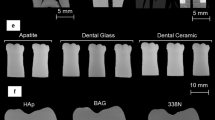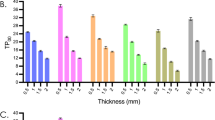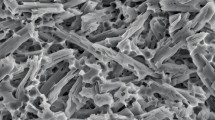Abstract
Simulation of tooth preparation using rotary cutting instruments is viewed as beneficial and essential in dental training. Various types of materials have been used for simulation systems in dental preclinical training. However, the phantom tooth materials used for simulation have not changed significantly for decades and they are acknowledged to be different from natural teeth. This study investigated the mechanical properties and microstructure of a widely used phantom tooth material and compared them with a novel, polymer infiltrated, ceramic. It was concluded that the polymer infiltrated ceramic has mechanical properties more similar to natural teeth than current phantom tooth materials, suggesting that it might be a good candidate material for phantom teeth for trainees to acquire initial tactile sense for tooth preparation.


Similar content being viewed by others
References
Green TG, Klausner LH. Clinic simulation and preclinical performance. J Dent Educ. 1984;48:665–8.
Buchanan JA. Use of simulation technology in dental education. J Dent Educ. 2001;65:1225–31.
Oliver WC, Pharr GM. An improved technique for determining hardness and elastic modulus using load and displacement sensing indentation experiments. J Mater Res. 1992;7:1564–83.
STEM E1820-08a. A standard test method for measurement of fracture toughness. Philadelphia: American Society of Testing and Materials, 2008.
Lawn BR, Marshall DB. Hardness, toughness, and brittleness—indentation analysis. J Am Ceram Soc. 1979;62:347–50.
Boccaccini AR. Assessment of brittleness in glass-ceramics and particulate glass matrix composites by indentation data. J Mater Sci Lett. 1996;15:1119–21.
He LH, Fujisawa N, Swain MV. Elastic modulus and stress–strain response of human enamel by nano-indentation. Biomaterials. 2006;27:4388–98.
Dickinson ME, Wolf KV, Mann AB. Nanomechanical and chemical characterization of incipient in vitro carious lesions in human dental enamel. Arch Oral Biol. 2007;52:753–60.
Angker L, Swain MV. Nanoindentation: application to dental hard tissue investigations. J Mater Res. 2006;21:1893–905.
Shibata Y, He LH, Kataoka Y, Miyazaki T, Swain MV. Micromechanical property recovery of human carious dentin achieved with colloidal nano-b-tricalcium phosphate. J Dent Res. 2008;87:233–7.
Bajaj D, Arola DD. On the R-curve behavior of human tooth enamel. Biomaterials. 2009;30:4037–46.
Yan J, Taskonak B, Mecholsky JJ. Fractography and fracture toughness of human dentin. J Mech Behav Biomed Mater. 2009;2:478–84.
Mowafy OME, Watts DC. Fracture toughness of human dentin. J Dent Res. 1986;65:677–81.
Author information
Authors and Affiliations
Corresponding author
Rights and permissions
About this article
Cite this article
He, LH., Purton, D. & Swain, M. A novel polymer infiltrated ceramic for dental simulation. J Mater Sci: Mater Med 22, 1639–1643 (2011). https://doi.org/10.1007/s10856-011-4350-3
Received:
Accepted:
Published:
Issue Date:
DOI: https://doi.org/10.1007/s10856-011-4350-3




